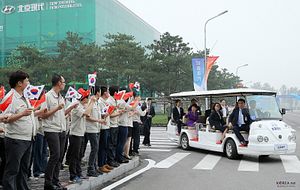As close neighbors, trade volumes between China and South Korea have increased at an amazing pace, growing almost 50-fold since the early 1990s. Personnel exchanges also have ever been more frequent. Economic cooperation therefore could be regarded as one of the main themes in Sino-ROK relations, and obviously it is a very important one. China, naturally, has become the primary destination for South Korea’s overseas investments.
Still, there have been some missteps, especially in 2008, when a large number of South Korean businesses rapidly retreated from several places in Shandong province, such as Qingdao, Yantai, and Weihai. A changing market situation helped drive those sudden retreats, but a “refocusing” of South Korean investment strategies was also at work. On the surface, it seems that some South Korean businesses left the Chinese market in the wake of the 2008 financial crisis. However, digging deeper, it may be that those “retreats” were a result of rapid and significant changes in the Chinese market and business environment. A number of South Korean businesses failed to successfully cope with the changes, adjustments, and strategic upgrades in China’s domestic market.
To boost their competitiveness, South Korean businesses should clarify and identify strategic trends in the Chinese market. By taking a big picture view that observes and studies China’s strategic moves on important political, diplomatic, and economic matters, South Korean companies can ensure a stable market share and future profits in the Chinese market.
Samsung, for example, seems to hold a different vision than those “retreating” companies. Rather than “refocusing” (in a narrow sense) or even “retreating,” Samsung made the strategic decision to march into China’s large western region. In 2012, Samsung finalized a $7 billion deal with Shanxi province and Xi’an city to launch a high-tech manufacturing plant. Samsung’s decision sparked a new round of the “Korean wave” (interest in Korean music, movies, and TV dramas) in China, especially among younger people in the Xi’an area who may seek jobs brought by Samsung’s entrance. Meanwhile, other South Korean giants like LG and Hyundai have signaled that they intend to follow Samsung into inland China.
The timing is perfect. Samsung made its strategic move just as China unveiled the new “Silk Road Economic Belt” strategy. China’s plan to develop its western regions envisions central China as the hub of a large economic belt that connects China, central Asia, the Middle East, and the European Union. This modern-day “Silk Road” provides huge opportunities, not only to Samsung but to any enterprises that seek further opportunities in China’s changing market.
Meanwhile, the “Silk Road Economic Belt” does not end at China’s eastern border. It surely extends to two eastern neighbors: South Korea and Japan. South Korean enterprises like Samsung and other leading corporations in industries like heavy construction have an opportunity to go far by taking advantage of this economic belt. We’re seeing the emergence of a long economic corridor connecting economically vibrant Northeast Asia and another economic superpower, the EU. How to enter this corridor and find new opportunities could be very important for South Korean businesses in the long term.

































